 Want to use a Facebook group for business?
Want to use a Facebook group for business?
Wondering how to promote your products and services in Facebook groups?
Whether you create a Facebook group or join one managed by someone else, you can use groups to position yourself, find new customers, and more.
In this article, you'll discover how to use Facebook groups to support and market your business.
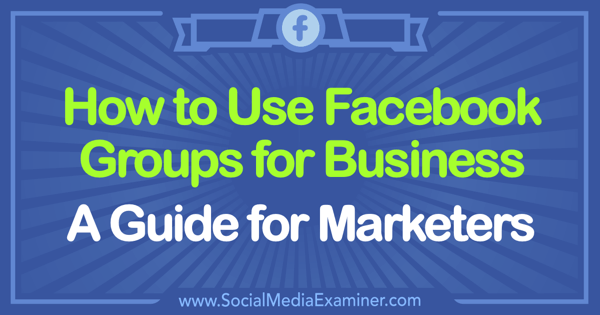
Why Should I Join Facebook Groups for Business?
Facebook groups bring together individuals who share a common interest. When you join a group that's made up of people who match your target customer, you'll have multiple opportunities to improve awareness of yourself and your business by being helpful.
To reveal those opportunities, simply type a keyword or topic into the search box on the right-hand menu of the group's page.
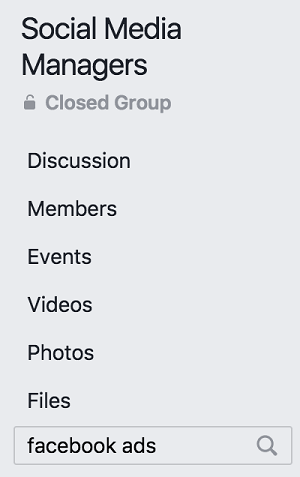
You'll see that people are asking a lot of questions inside groups. Find the questions that will let you demonstrate your expertise or specialized skills. You can answer the questions outright, share a helpful blog post, or even mention your own products and services.

This kind of marketing is very powerful because it's highly targeted. People need answers to their questions and if you can provide solutions on a regular basis, you and your business will start to become top of mind with members of the group. People may even start to look to you for answers by tagging you in comments.
You can also use these searches to gather FAQs and create original content for your potential customers.
How Do I Find Groups on Facebook?
Think of groups run by other people as mini-communities. There's a group for virtually anything and everything, and you can join up to 6,000 groups. Here's how you can join a Facebook group or two, and engage daily with other members.
Log into your Facebook personal profile account and find Groups on the left-hand side of your Home page in the Explore section.
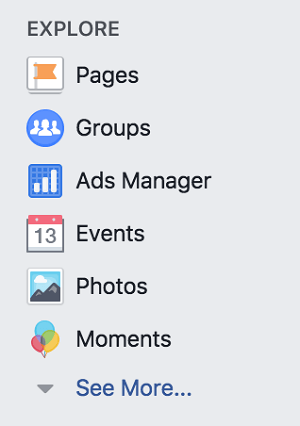
Once you click on the Groups tab, you'll automatically be sent to the Discover Groups landing page. This is where Facebook suggests groups for you based on criteria such as pages you've liked, groups your friends are members of, and so on. Facebook will also let you see which of your friends are members of the groups suggested to you.
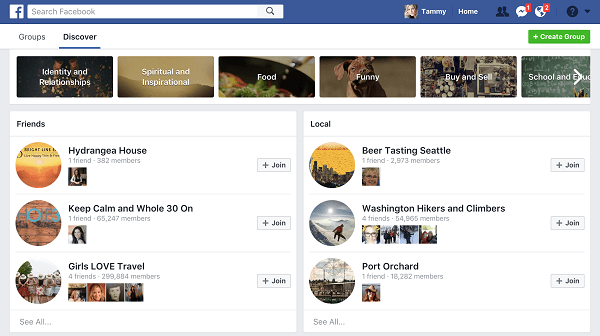
As you browse through the suggested Facebook groups, you'll see both public and closed groups.
Get World-Class Marketing Training — All Year Long!
Are you facing doubt, uncertainty, or overwhelm? The Social Media Marketing Society can help.
Each month, you’ll receive training from trusted marketing experts, covering everything from AI to organic social marketing. When you join, you’ll also get immediate access to:
- A library of 100+ marketing trainings
- A community of like-minded marketers
- Monthly online community meetups
- Relevant news and trends updates
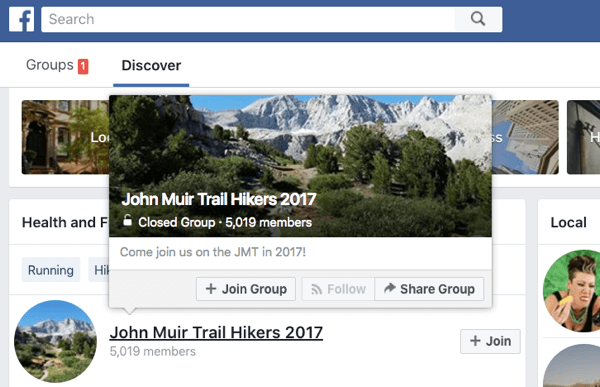
Click on any group to learn more about it by reading the description to understand the group's mission. Be sure you're a fit before you ask to join.
Many group owners will also post specific rules for engaging inside the group. Rules are often posted in the Description area or in a post that's been pinned to the top of the timeline. It's important to read the rules so you don't get barred from the group.
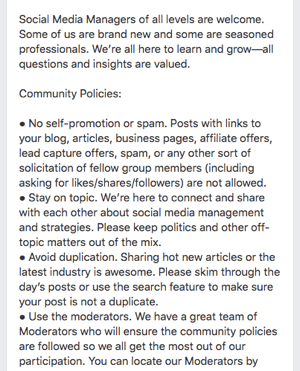
Once you find a group to join, just click the Join button. Be aware that some groups, like this one, will ask you to answer a few entry questions before sending your request along to the group owner.
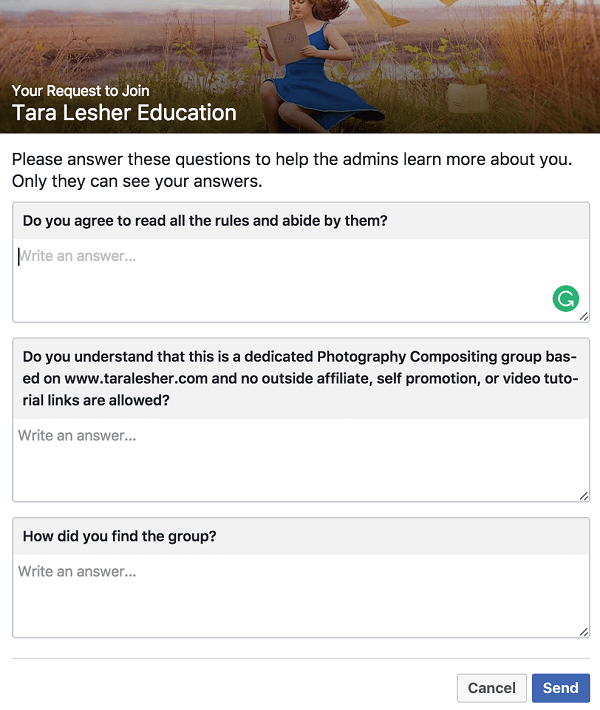
After you answer the questions, you'll get a message letting you know that your request is pending and you'll get a notification when your request to join has been approved.
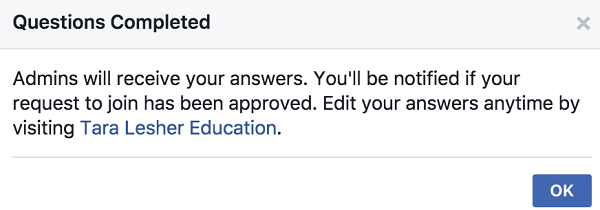
When the group is opened to you, spend some time looking through the posts to get a feel for how it operates. Once you understand the tone of conversation, and the way other members ask and answer questions or offer advice, you'll be able to successfully do the same.
Why Should I Create My Own Facebook Group?
While participating in Facebook groups managed by others can help you promote your brand and business, you have to play by others' rules. Managing a dedicated Facebook group of your own lets you control the entire group experience and use your group for a specific purpose.
Before you begin to build your group on Facebook, you need to decide why and how you'll use the group. Here are four ways groups are commonly used by business owners.
Create Community Around Products: Many groups are created by businesses as a bonus when somebody buys their product or service. Creating communities around the products and services you sell makes members feel exclusive and provides an area where they can get additional help and training from you.

Establish Authority: Create a group for email subscribers to further inspire and educate them with helpful posts and prompts. Share helpful articles, tips, tricks, and even tutorials in the group to help improve members' lives and businesses.
Create a Topic-Focused Community: Rather than using your business name to identify your group, give it a name that reflects a specific topic on which you're an expert; for example, Social Media for Health Care Providers. This will draw people who are interested in that topic.
Once you've decided how and why you'll use your group, you can start to build it.
#1: Create a Facebook Group for Business
Click on Create a Group on the main Group page we accessed from the left-hand side of your Facebook personal profile. You'll then see a screen where you give your group a name, add people, and set the group's privacy level.
You'll need to add at least one person to your group before you can create it. Choose someone who knows you're building the group but will keep it under wraps until you're ready to launch.
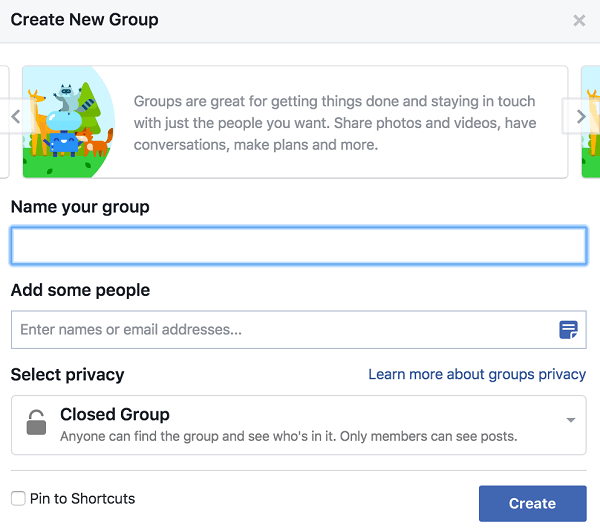
Facebook groups can be public, closed, or secret, depending on the goal of your business. The descriptions below can help you decide which is right for you.
Public Facebook Groups: Anyone can join and everyone can see the group posts. Public groups can attract people who join simply to spam other members with their own content. If you decide to build a Facebook group community around a certain topic or event, a public group may work well.

Discover Proven Marketing Strategies and Tips
Want to go even deeper with your marketing? Check out the Social Media Marketing Podcast! Publishing weekly since 2012, the Social Media Marketing Podcast helps you navigate the constantly changing marketing jungle, with expert interviews from marketing pros.
But don’t let the name fool you. This show is about a lot more than just social media marketing. With over 600 episodes and millions of downloads each year, this show has been a trusted source for marketers for well over a decade.
Closed Groups: Anyone can ask to join, but requests have to be accepted by a group administrator. If you're not a member of a closed group, you won't be able to see group posts. This is helpful because you can educate your members with tutorials without giving everyone the ability to see your training. The closed group is the most popular for business.
Secret Groups: Only members will see group posts and the group can't be found in search. Secret groups are a great way to establish the authority of your business. Secret groups are for very specific members and are often centralized around a service you provide like high-level coaching. You can even have people pay a monthly fee to join your group.
After you choose your privacy settings, click Create and your new group will be ready for you to load images, details, and settings preferences.
#2: Customize Your Facebook Group
Add a cover photo that's 828 x 315 pixels. When the image shows on the group's timeline, click on it to create a thorough description and the rules for your group.

Now click on the ‘…' button to complete the Settings options for your group.
Decide on the Group Type
The type of Facebook group designation you choose will depend on its purpose. Will you educate people, provide customer support, or create a group around an event for your business?
Choose the right Facebook group type to let Facebook know how to categorize your group for search results.
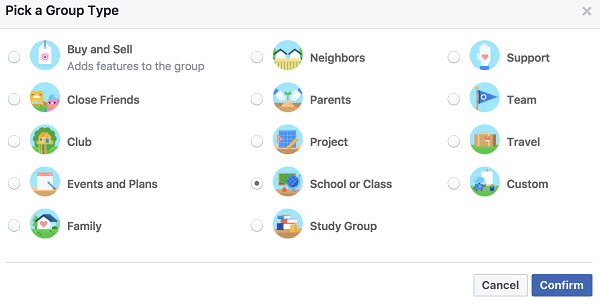
After choosing a group type, complete the Description, Tags, Locations, and Web and Email Address settings.
When your group looks the way you want it, it's time to add three to five posts so new members have something to read. Make sure one of those posts is a set of rules members should keep in mind, then pin that post to the top of your timeline. This will help you save time because the rules are clear and agreed upon.
#3: Invite People to Join Your Group
Now that your group is up and running with a few posts, it's time to invite people to the group.
Depending on the type of group you created, decide if your personal friends would be a good fit. Do you own a local restaurant? Invite your family and friends to the group to showcase new menu items, events, and so forth.
For many business owners, friends and family are not paying customers. While they would be happy to support you, you may want to keep them out of the group. Focus on people your group serves and find out where they are.
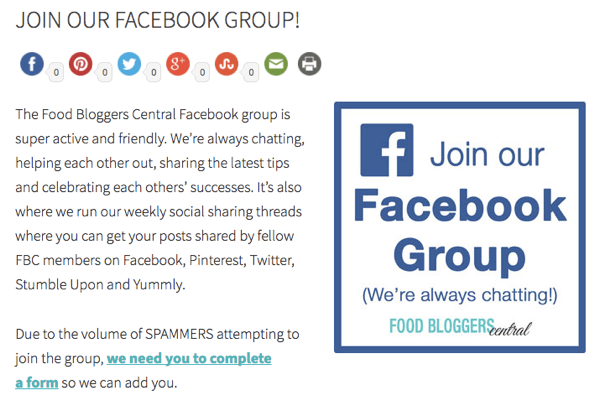
Here are a few options for you to consider:
- Add an invitation for website visitors to join your group.
- Send your email subscribers an email introducing your new group and give them a link to the group's page.
- Share the link to your new group on all of the social media platforms you're active on.
- Add a social button on your website that takes people to your group's Facebook page to join.
- Include an invitation to join your group on the thank-you page for your lead magnet.
#4: Curate Content for Your Group
Before launching your Facebook group, take some time to define a long-term content strategy that supports the group's goal. For example, is the goal of your group to sell to members? Do you want to create a support group for people who've already purchased from you?
You'll also need to decide what type of content you'll serve. Will you provide inspirational, educational, or entertaining content? Will you prompt group members to engage?

Finding Content for Your Group
If every post you publish brings value to the group, members will be more likely to engage with your content. Here are a few places to find trending or interesting content to share with your members.
- Buzzsumo.com: Buzzsumo shows users what topics are trending in the moment. You can also search specific topics related to your group to find the most popular articles and which social media platform they were shared on. Here's what Buzzsumo comes up with when I type in “social media marketing.” These are the top three articles in the past week. I can share this popular content inside my group to support and educate members.
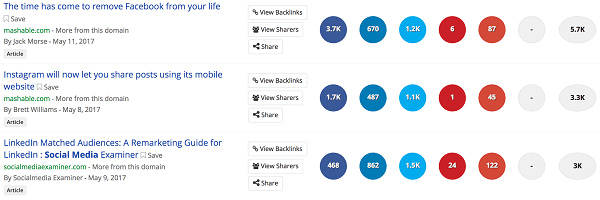
- Google News: The quickest way to find the most recent articles to share with your group members is to type your search query into Google and then select News to filter the most recent articles. Sharing relevant and recent content establishes you as the expert for the group.
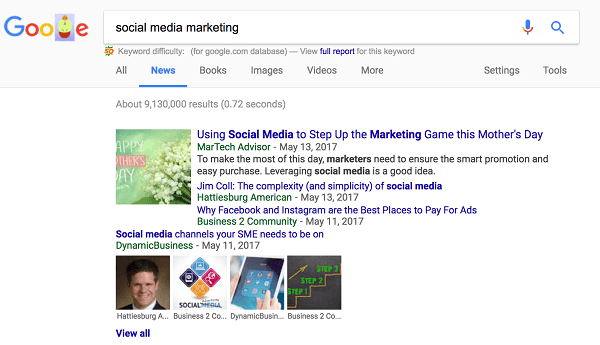
- Industry awareness: Listen to podcast episodes about your group's topic and continue to stay up to date with other types of content your group members might like.
Above all, read and comment on member questions and interactions with other members.
#5: Encourage Members to Engage
If you want to create a successful group for your business, make sure to post things that will spark interaction with your content or among group members. Use these six ideas to create and deliver custom content for your own group.
- Challenges: Challenges have become a very popular activity inside groups. Do you provide a consulting service? Design a challenge and invite members to join it. At the end of the challenge, invite them to work with you one on one if they're ready to take their learning to the next level.
- Tutorials: Tutorials are a great way to continue establishing your business as the leader in the industry. Each week post a tutorial video that seeks to help and support your members.
- Live Q&As: The live question and answer type activity has become popular in larger groups. As your group grows, you can offer a Q&A session once a week to continue to help and support your group members.
- Quizzes: Quizzes are fun for group members, and they're also helpful to gather data from members of your group. Use quizzes to find out what your next product or service should be by asking members to take the quiz.
- Polls: Need new content ideas? Create a poll for your group to vote on. Create polls for your next blog title, logo, or type of content for the next month.
- Daily Theme Prompts: Daily prompts allow group members to post about a certain topic each day. Typically, there's a promotional day when group members can share their latest blog post or product. Ask members to post photos of your place of business or product. These daily prompts can be a great way to set expectations for members and give them a chance to share about themselves.
Consider Hiring a Community Manager
As your group grows and becomes active, you may need to hire a community manager. A community manager will help monitor all posts and comments so you can focus on the weekly objectives of the group. Most community managers are found inside the group. You'll likely have one or two group members who are very active and helpful inside the group. They're your ideal candidates for helping you manage your time inside the group.
Want more like this? Explore Facebook for Business!
.
Summary
Groups can be a powerful way to establish your expertise; create an engaged community; and find new customers, peers, and partners.
Will you use Facebook groups as part of your marketing strategy? What other questions do you have about Facebook groups? Let us know in the comments below.
Attention Agency Owners, Brand Marketers, and Consultants

Introducing the Marketing Agency Show–our newest podcast designed to explore the struggles of agency marketers.
Join show host and agency owner, Brooke Sellas, as she interviews agency marketers and digs deep into their biggest challenges. Explore topics like navigating rough economic times, leveraging AI, service diversification, client acquisition, and much more.
Just pull up your favorite podcast app, search for Marketing Agency Show and start listening. Or click the button below for more information.

